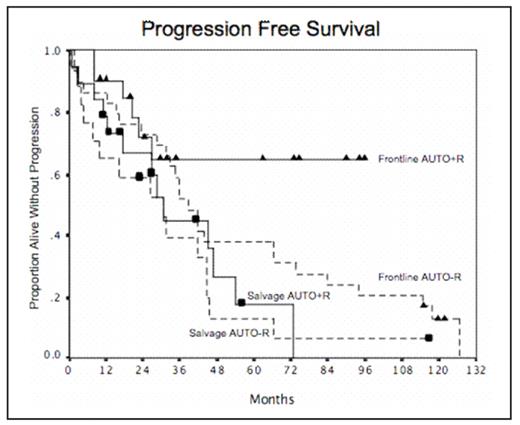Abstract
In order to determine if the addition of rituximab (R) had changed the outcome of autologous stem cell transplantation (AUTO) in patients with mantle cell lymphoma (MCL), we examined the outcome of 86 patients transplanted at the MD Anderson Cancer Center, in first partial or complete remission (frontline AUTO, n=50) or for relapsed / refractory disease (salvage AUTO, n=36).
<<<FRONTLINE AUTO>>> Among frontline patients, 29 were transplanted in the pre-R era (AUTO-R), and 21 in the post-R era (AUTO+R). AUTO-R patients received homogenous treatment with hyper-CVAD induction and Cy- TBI conditioning. AUTO+R patients were treated with R-hyper-CVAD, hyper-CVAD and R-CHOP induction in 62%, 10% and 29% respectively, and R-Cy-TBI and R-BEAM conditioning in 43% and 52% respectively. Median age (range) at transplantation was 57 (42–66) and 56 (38–73) for the AUTO-R and AUTO+R groups respectively (p=0.91); other baseline characteristics including sex, time from diagnosis, performance status, stage, B-symptoms, B2m, LDH and MIPI were similar. Prior to transplantation, CR or unconfirmed CR (CRu) was present in 38% and 57% of AUTO-R and AUTO+R patients respectively (p=0.18), and 33 of 34 patients were negative on Gallium/PET scan. Following transplantation, CR/CRu was achieved in 93% and 100% patients respectively (p=0.50). Progression free survival (PFS) was similar between AUTO-R and AUTO+R patients for the first 2 years. However, after 2 years a clear difference emerged on the PFS curve with no relapses occurring among 9 AUTO+R patients followed between 30 and 96 months. In contrast, AUTO1-R patients experienced a continuous pattern of relapse (p=0.03 compared with AUTO+R patients). For patients remaining in remission at 2 years, no deaths had occurred in the AUTO+R group, whereas 15 of 22 AUTO-R patients had died.
<<<SALVAGE AUTO>>> The 36 salvage patients had similar baseline characteristics as frontline patients, except for the proportion of patients with chemosensitive disease (100% vs 86%, p=0.01) and negative Gallium/PET scans (97% vs 71%, p=0.01), favoring the frontline group. In contrast to the results of frontline patients, no difference was observed in salvage patients by the use of R (p=0.52 and 0.50 for PFS and OS respectively).
<<<CONCLUSION>>> Autologous transplantation with rituximab has the potential to cure a proportion of patients with MCL, but only if performed during the first remission. Patients transplanted beyond first remission continued to experience a poor prognosis.
Disclosures: No relevant conflicts of interest to declare.
Author notes
Corresponding author


This feature is available to Subscribers Only
Sign In or Create an Account Close Modal